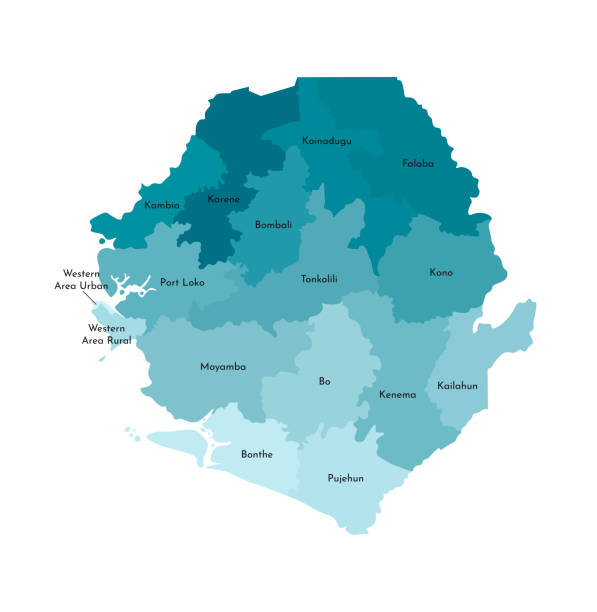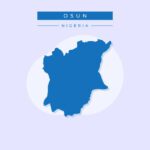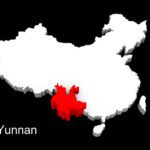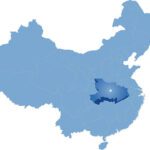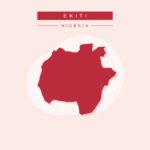Families are the basic unit of society, and their well-being is essential for the overall development of a community or a nation. This report provides an overview of family life in the North West Province of Sierra Leone. Data for this report was obtained using open-sourced information.
The report’s main objective is to provide a concise overview of the conditional state of families using available family demographic statistics (e.g., number of families, family structure, racial and ethnic diversity, marriage rates, divorce rates, family income, etc.).
This report is written for stakeholders with an interest in family life in the North West Province of Sierra Leone. This approach makes certain that the report’s findings are transparent and replicable, and stakeholders can access, verify, and utilize the data sources themselves.
Overview
The North West Province of Sierra Leone was established in 2017 and it borders Guinea to the left .The province was created from the Northern Province. There are three districts that make up this province:Kambia, Karene (also established in 2017) and Port Loko. The North West Province has a population of 1,186,050 and covers 13, 527 kilometers. Similarly, in the North West province there are 37 chiefdoms, which refers to an area governed by a chief. Refer to the link about the chiefdoms for more information.
From the Pacific Diaster Center 2020’s district profiles of Sierra Leone, landscape in Kambia district is low-lying plains with vegetation and soil covering the majority of this area. The Great and Little Scarcies Rivers lie within the district. In Port Loko, this area is a major trading center and it is rich with iron ore , gold and bauxite. Unfortunately, there is no mention of the district of Karene in the district profiles.
“Nor-d Weh-st Pro-vince
Demographics and Ethnic Diversity
Kambia district is home to several prominent ethnic groups, such as Temne, Susu, Limba, Fula, and Mandingo. On the other hand, the Temne are the most populous ethnic group in Port Loko and Karene districts. The Temne, Susu, and Fula ethnic groups are rooted in Futa Jallon, present-day Guinea. Most of these ethnic groups have migrated from Guinea. The Maningo ethnic group originates in Guinea, specifically in the Sankaran area. The Limba, on the other hand, are thought to have originated in Sierra Leone. In terms of languages, several dialects are spoken in Port Loko and Kambia, including Krio, Susu, and Temne.
Family Structures and Traditions

Port Loko, Sierra Leone, Africa – June 6, 2013: Port Loko District North of Sierra Leone, road sign on the bridge over the river
While the North West Province’s general family structure is not described specifically, the overall family structure in Sierra Leone includes an extended family setup, comprising parents, children, grandparents, uncles, aunts, and cousins living together in compounds, which refers to clusters of homes living in an enclosure. The average family size (nuclear) in Sierra Leone is about 5 individuals, with urban households being slightly smaller than rural households (5.1 persons vs. 5.4 persons). From the Pacific Diaster Center 2020’s district profiles of Sierra Leone, 7 persons per nuclear family (mother and father) were reported for the Kambia and Port Loko districts. Additionally, a 2019 demographic report stated, “Women’s ideal family size is highest in the North West province (5.3 children) and lowest in the Western Area province (3.9 children)” (p. 91). Therefore, the assumption of 5 persons per nuclear household is made with the recognition that there may be other extended family members residing in a household.
Moreover, many households in Sierra Leone are headed by men, with one parent usually responsible for providing financial support. Typically, women take care of the household and children. Additionally, teenage female students are responsible for cooking meals for the entire family. Both extended family members and the community take part in childcare. It is uncommon for a mother to allow her child to reside and be taken care of in an extended family’s home although the mother is actively involved in her child’s life.
Marriage and Divorce Rate
In Sierra Leone, marriage and divorce laws can be governed by the general law, Islamic law, or customary law. Under the general law, which includes the Christian Marriage Act and the Civil Marriage Act, marriages should be monogamous and have specific requirements to be legally valid. The Islamic law allows men to have up to four wives, provided they can take care of them equally and fairly. On the other hand, customary law marriage formation varies from one ethnic group to another and requires the consent of the wife’s family. Under customary law, a man can marry as many wives as he desires and can afford. For more information please refer to the link for this citation.
Similarly, marriage customs in Sierra Leone are defined by ethnic groups and socioeconomic status. The groom is expected to pay a bride price which is determined by the bride’s family. Marriages can be arranged or now commonly based on love marriages. The following paragraph is about marriage and divorce rates.
The information reported here about marriage and divorce rate is prior to the North West Province formation. As mentioned previously, North West Province was formed from the Northern Province in 2017, therefore the data described includes parts of the North West Province. According to the 2015 Sierra Leone Census, from a population of 1, 709, 916 people (rural/urban): 736,606 were never married, 53, 250 are engaged, 264, 296 married monogamous , 542, 038 married polygamous, 4, 552 in cohabitation for less than 5 years, and 1, 648 in cohabitation for more than 10 years. In addition, 19, 616 are separated, 13, 075 divorced, 70, 350 widowed and 4, 485 have an unknown status (p. 70).
Culture and Heritage
Although I could not find information about the culture and heritage practiced in the North West Province of Sierra Leone, generally I will speak about general culture and heritage found in Sierra Leone. For example, étiquettes, Sierra Leoneans are socialized to be well mannered and polite. They pay attention to one’s neatness of clothing and style of presentation of clothing. Greeting and treating people with respect and courtesy is important.
When it comes to cuisine, rice, stew and fufu are staple dishes. In fact, rice is seen as an integral part of Sierra Leoneans diet. Rice may be served with sauces or stews made with cassava leaves (national dish), potato leaves, okra, or peanut butter sauce.
Likewise the culture and traditions practiced in Sierra Leone is very diverse, most practices are tied to ethnic groups. One example of a culture practice is called Bondo Society, which is the transition from childhood to womanhood and the initiation is performed through female circumcision. Young girls and their families celebrate this initiation by buying new clothes for the girls and cooking food for others to celebrate with the family. Additionally, ceremonial dances are common in Sierra Leone with each ethnic group having specific traditional clothes and dance. Drums, wooden xylophones and other string instruments are used as background music for cultural festivals. Similarly, wooden masks are used during cultural festivals. For example, Arong Athoma is a carved mask by the Temne people. Lastly, holidays like Christmas and Ramadan are popular holidays to celebrate among the people.
Socioeconomic and Family Well-being
Various economic activities occur in the North West Province of Sierra Leone. In the Kambia district, the primary source of livelihood is farming, with crops like rice, cassava, and yam being grown. Cross-border trade with neighboring Guinea is also common. Additionally, fishing is an alternate means of earning money, where men engage in fishing activities, and women sell the catch in the market. Moreover, labor exchange and hiring are prevalent practices in the region.
Similarly, in Port Loko, farming is the primary source of income for around 80 percent of the population. Rice, cassava, and sweet potatoes are some of the crops grown in this area. Small-scale mining activities also occur here, with the areas surrounding Port Loko known for bauxite mining. The city of Port Loko is a significant trade center in the Northern Province, with the London Mining Company being a significant employer in the region, operating iron-ore mining in Lunsar and Marampa.
Education
Sierra Leone places a high value on education, but unfortunately, the number of people who complete primary and post-primary education remains low. The academic year in Sierra Leone typically starts in September and ends in July, with children starting primary school at the age of 6. The education system is structured in such a way that the primary school cycle lasts for 6 years, the lower secondary lasts for 3 years, and the upper secondary lasts for 4 years. It is mandatory for all children aged 6 years to attend primary school and 3 years in junior secondary school. However, due to a shortage of schools and teachers, implementing this policy has been a challenge. According to a 2019 survey report, 47.3 percent of Sierra Leoneans residing in the North West Province have no education while approximately 50 percent have some education experience (e.g., 32.7 % with some primary, 2.1 % completed primary, 15.5 % some secondary education). In general, urban areas have higher rates of education and literacy attainment than rural areas.
In Kambia district , educational attainment is higher in boys compared to girls. The literacy rate for men is 43 percent compared to 20 percent for women. In 2015, 424 schools were reported to be in this district. Whereas, Port Loko is reported to have the largest number of schools after Freetown (N = 687, of which 39 are pre-primary, 512 are primary, 111 are junior secondary, and 25 are senior secondary schools ). Reports about Karene district education statistics are not here because there was no district profile for Karene.
Despite the low percentage of education in Sierra Leone, the government, however, in 2018 introduced a program called Free Quality School Education (FQSE). The intent is to provide quality education for everyone, from children to adults. FQSE will provide primary education up to completion of high school for children and technical and vocational schooling for youths and adults free of charge. The pilot program is currently going so the final impact is unknown.
Conclusion
Despite being a recently formed province in 2017, the North West Province of Sierra Leone boasts a rich diversity of people and cultural practices. The locals are known for their strong sense of community and actively engage with their families. The province’s landscape is versatile, utilized for various activities such as farming, fishing, cross-border trading, small-scale mining, and other forms of labor. However, to gain a more in-depth understanding of the families and their way of life, more detailed information is required. This report aims to capture a glimpse of the North West Province’s vibrant culture and lifestyle.

